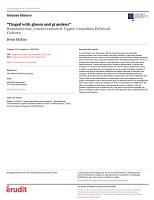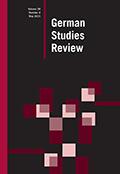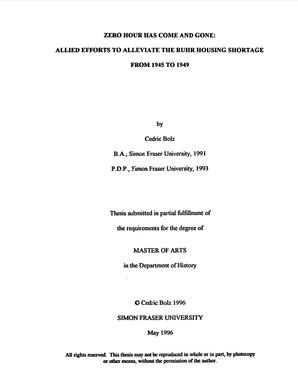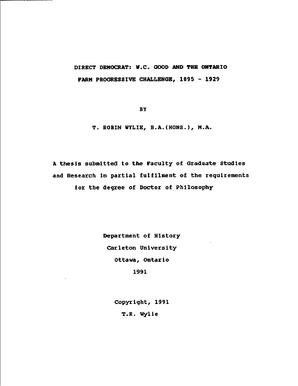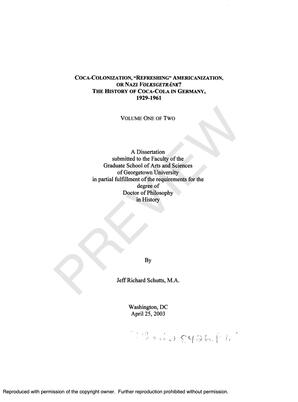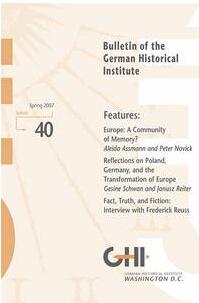History
Related Works
Content type
Digital Document
Description / Synopsis
Presented at the <a href="https://cha-shc.ca/about/what-we-do/annual-meeting/">Annual Meeting of the Canadian Historical Association</a>, Toronto, Ontario (June 2-4, 2025)
Origin Information
Content type
Digital Document
Abstract
Scholars have discussed the role of romanticism in the condescending attitudes of Upper Canadian conservatives toward Indigenous peoples but they have yet to examine its role in the political culture of settler society; specifically, as it applies to the political ideology of Tories, the group that prevailed in bustling towns and embryonic outposts alike. Weaving together intellectual history, the history of emotions, and environmental history, this article explores the romantic tradition’s salience within the mentalité of Upper Canadian conservatism. It contends that influential figures from the worlds of politics and literature repeatedly invoked aspects of romanticism over several decades in denouncing subversive phenomena and in seeking to legitimize their vision of a hierarchical society. In particular, they drew on such compelling romantic tropes as powerful emotions and the magnificence of nature in the hope of bolstering a social order predicated on elite hegemony and rank-and-file deference. This helps to shed light on one of the animating factors within the Tory tradition, a multifaceted force that, for good or ill, has played an important role in shaping Ontario’s history.
Origin Information
Content type
Digital Document
Abstract
Few German history topics have garnered as much attention as the nuanced meaning of Heimat and the controversial past of the Krupp steel firm. This article examines their historical intersection in the housing realm. Between 1914 and 1931, when the impact of World War I entirely reframed the housing question, Heimat advocates like Hermann Muthesius and Paul Schultze-Naumburg used examples of Krupp estates to depict their vision of the ideal German home. These historically neglected Krupp settlements were hybrids of vernacular and modern influences and served as significant precursors to the dominant Kleinsiedlung housing still dotting the German landscape. [ABSTRACT FROM AUTHOR]
Origin Information
Content type
Digital Document
Abstract
The author has placed restrictions on the PDF copy of this thesis. The PDF is not printable nor copyable.
Origin Information
Content type
Digital Document
Abstract
As the central pillar of the Krupp steel firm’s much-publicized company
welfare initiatives, employee housing has played a vital role in shaping Krupp’s
corporate identity from 1855 to the present. The central objective of this
dissertation is to examine and critically assess primary and secondary sources
written about Krupp housing in order to determine its historical meaning and
impact. Previous historical writings on Krupp have predominantly overlooked the
fact that at the conclusion of World War One, Essen’s Friedrich Krupp A G was
not only Germany’s largest steel producer and leading armaments manufacturer,
but with over 12,000 units constructed also the nation’s largest private sector
provider of housing. While Krupp’s integral involvement in the German war
effort and the brutality of trench warfare would contribute to transforming its
international reputation from the “Armoury of the German Empire” to “Merchants
of Death”, domestic Heimatkultur [native culture] publications were heralding the
company’s housing initiatives as blueprints for planning the post-war communities
of returning soldiers. It is the fascinating dualism of the firm’s reputation as both
agents of mass destruction and apparent social welfare innovator that provides the
central impetus for this study.
This dissertation examines the social, economic, political and cultural forces
that combined to define the historical significance of Krupp housing activities. Of
particular interest in this regard was the role Germany’s largest industrial complex
played in promoting cultural perceptions about German housing. More
specifically, it depicts how Krupp’s extensive housing activities and marketing
strategies influenced the early development of the German Kleinsiedlung form
during a period (1892-1941) that spanned the Wilhelmine, Weimar and National
Socialist years. This study thus contributes another chapter to the growing
scholarly literature on the history of the German Kleinsiedlung that Tilman
Harlander has fittingly described as a ''spezifisch deutsche Geschichte” [specifically
German story]. Within this story Krupp’s company housing legacy represented a
Sonderweg [a distinct path].
After having analyzed and thoroughly contextualized the wide range of historical
writings on Krupp housing, I conclude that by 1918, three Krupp housing projects in
particular — the Altenhof, Margarethenhöhe, and Heimaterde — represented highly
influential and equally controversial working models of urban planning and social
engineering. The most pronounced historical impact of Krupp’s housing was that it was
not only portrayed but also interpreted as a very bold, large-scale intervention into
alleviating the housing crisis long before this problem was directly addressed by the
German state after World War One. Krupp not only possessed the initiative, but more
importantly, the financial means to transform theory into practice. In particular for
reformers of the political right, Krupp’s Sonderstellung [distinct status] in the German
political economy, combined with the absence of labour militancy in the nation’s most
heavily industrialized city, proved highly inspirational for their urban planning ideas.
Between the final years of the Weimar Republic and the outbreak of the Second World
War, this impact would reach unprecedented heights. When noted National Socialist
idealogue Gottfried Feder published his blueprint for the ideal new cities of the Third
Reich in Die Neue Stadt: Versuch der Begründung einer neuen Stadtplanlmnst aus der
sozialen Struktur der Bevölkerung [The New City: An attempt at founding a new
planning artform out of the social structure of the population] (1939), he cited Krupp’s
Margarethenhöhe and Heimaterde as „vorbildlich praktische Beispiele" [exemplary
practical examples] of „musterhaften Groβsiedlunger” [model large settlements].
Origin Information
Content type
Digital Document
Origin Information
Content type
Digital Document
Abstract
This case study in the “globalization” of Coca-Cola examines the cross-currents of cultural transfer. After defining Coca-Cola (soft drink, company, and icon) via its history in the United States, the dissertation examines Coke's launch in Germany by Ray Rivington Powers, an American expatriate who in 1929 established a bottling franchise in Essen. Although the Great Depression bankrupted other international Coca-Cola bottling operations, the soft drink's sales in Germany doubled annually throughout the 1930s—a remarkable accomplishment considering the Nazi's national chauvinism and Coca-Cola's status as “The Great American Beverage.”Drawing from many sources—from German periodicals and government archives to Coca-Cola company publications preserved by private collectors—this study investigates the secret of Coca-Cola's success. Although Powers embodied Weimar Germany's so-called “Americanization,” Coca-Cola itself was “Germanized” in the Third Reich: The Coca-Cola Company's business organization and marketing methods facilitated the transformation of the soft drink into an “indigenous” product that was promoted by local family businesses. Even when Coca-Cola GmbH's competitors tried to discredit Coca-Cola as “Jewish-American,” the German Coke franchise weathered the storm with advertising that suggested Germans, “Trink Coca-Cola eis-kalt.” In 1937 Coca-Cola's thorough integration into German culture was demonstrated when a bottling operation was set up amidst an exhibition of Schaffendes Volk, “the German people at work.”Coca-Cola did business with both sides during World War II. Whereas Coke's patriotism prompted the US Army to establish bottling plants wherever American forces deployed, in Nazi Germany Coca-Cola GmbH, administered as “enemy-owned property,” marketed a new ersatz soft drink—Fanta. After the war, Coke's unprecedented success in the new Federal Republic of Germany demonstrated how Coca-Cola was able to shape, as well as profit from, historical events. With its clever ad slogan, “Mach mal Pause,” Coca-Cola GmbH positioned the soft drink as an elixir for war-weary Germans. Sales skyrocketed, and the Coke bottle became an icon of the 1950s Wirtschaftswunder, West Germany's miraculous economic recovery. Coca-Cola consumption was a stage on which postwar Germans could rehearse a new “identity” as cosmopolitan consumer-democrats. In other words, they were “Born Again in the Gospel of Refreshment.”
Origin Information
Content type
Digital Document
Origin Information


